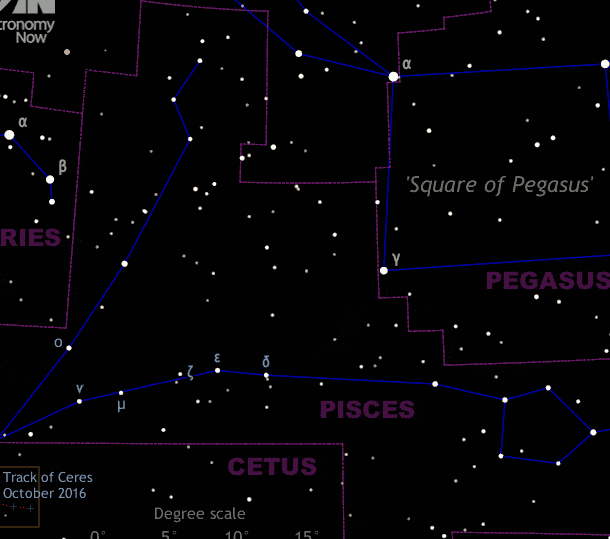An astrobiologist has put forward a proposal to abandon the concept of colonizing exoplanets and instead construct a mega-satellite in the orbit of Ceres. Let’s explore the possibilities that scientists are offering for the future of humanity.
Discover “Hitech” in
The Location of Ceres
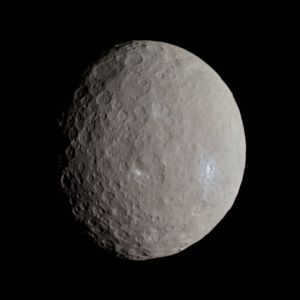
What are the circumstances on the dwarf planet?
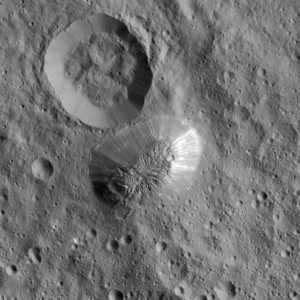
There are visible light and dark structures on the surface of Ceres, which are believed to be craters. In 2015, spectra obtained by the Dawn spacecraft showed the absence of water, but they did reveal the presence of a hydroxyl OH band and a slightly weaker ammonium band. This suggests the presence of ammoniated clay, where water is chemically bound in the form of hydroxyl. The presence of ammonia on Ceres is still unexplained, as its snowline is located far outside of Ceres’ orbit. Geologists from the United States, Italy, France, and Germany have analyzed images from Dawn’s main camera and discovered evidence of activity on Ceres’ surface, which is associated with a high water content in the upper layers of rock. They have identified three types of matter flows:
- The first type of displacement, which is mostly observed at high latitudes, resembles Earth’s glaciers. These are layers of soil that shift and collapse the edges of craters.
- The second type of displacement, also commonly found near the poles, is similar to landslides.
- The third type is typically associated with large craters and has a structure comparable to debris flows. Scientists compare it to specific craters where liquid outbursts occur – these occurrences are common on Mars, and on Earth, the Nördlingen Ries serves as an example.
All of these displacements are prevalent on the planetoid’s surface, and they can be observed near 20-30 percent of all craters larger than 10 km in diameter.
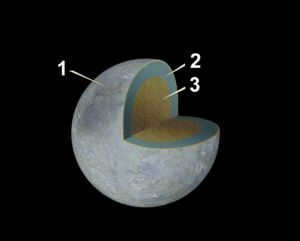
Exploring the Potential of Ceres for Colonization
The concept of colonizing Ceres presents an exciting opportunity for future space exploration and settlement endeavors.
Renowned NASA scientist, Al Globus, underscores the immense potential of orbital settlements compared to planetary and satellite surfaces:
When considering the combined surface area of the Moon and Mars, it amounts to only about a third of Earth’s surface. However, by utilizing material from the dwarf planet Ceres to construct orbital space colonies, the habitable area could be expanded to approximately 150 times the surface area of Earth.
Given that a significant portion of Earth’s surface is occupied by vast oceans and sparsely populated regions such as deserts, mountains, and forests, settlements built solely from Ceres material could potentially accommodate over a trillion individuals in comfortable housing.
In 2004, NASA conducted a competition to determine the best design for a space settlement. Among the winning projects was a space station located in the orbit of Ceres, which was designed to accommodate 10-12 people simultaneously. The project was created by Almut Hoffman from Germany.
Astronomers have calculated that Ceres contains approximately 25% water, potentially making it home to a greater water supply than all of Earth’s freshwater reserves combined. Unlike Earth, the water on Ceres is believed to exist in the form of ice within its mantle.
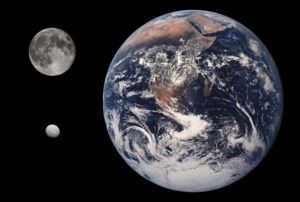
Challenges in the development of Ceres:
- Being located in the asteroid belt poses a risk of potential damage to the space base and spacecraft.
- Ceres lacks a magnetic field, which can have adverse effects on human health.
- Due to its low gravity, Ceres does not possess a dense atmosphere.
- There is a limited amount of sunlight available.
Colonizing a Mega-Satellite Orbiting Ceres
A novel concept for colonizing the massive satellite orbiting Ceres, a dwarf planet located in the asteroid belt between Jupiter and Mars, has been proposed by physicist Pekka Janhunen from the Finnish Meteorological Institute.
According to Janhunen, humanity could construct a vast colony on an artificially constructed “megasatellite” surrounding Ceres.
The colony’s inhabitants would reside within numerous cylindrical structures anchored within a disc-shaped orbit around Ceres. Each cylinder would be capable of accommodating up to 50,000 individuals, featuring an artificially generated atmosphere and simulating Earth’s gravity through centrifugal force induced by rotation.
“These cylinders provide a gravitational acceleration of 1 g, equivalent to that on Earth, which is crucial for the well-being and development of muscles and bones, especially in children,” explained Janhunen.
The theoretical physicist explained to Universe Today that Ceres has an abundance of nitrogen to create an artificial atmosphere and is also sufficiently large to offer virtually limitless resources. Additionally, Ceres is of a size that allows for cost-effective extraction of materials from its surface.
Considering the low gravity on Mars, I have come to the conclusion that it would not be possible for children in a Martian settlement to develop into healthy adults in terms of their muscles and bones. As a result, I have begun searching for an alternative solution that would provide a tethered world with gravity similar to that of Earth.
Pekka Janhunen, a scientist at the Finnish Meteorological Institute
The plan proposes that each cylinder will measure 10 kilometers in length, with a radius of 1 kilometer, and complete a full revolution in 66 seconds to replicate the gravitational force of Earth. These cylinders will be capable of rotating within a shared disk, kept in place by powerful magnets.
Additionally, the design includes two large mirrors positioned at a 45-degree angle to the disk. These mirrors will redirect ample sunlight towards the colony.
A portion of each cylinder will be dedicated to cultivating crops and planting trees, using soil that will be delivered from Ceres and will be 1.5 meters deep. These plants will serve as a source of food, oxygen, and will absorb excess carbon dioxide.
What other mysteries does Ceres hold?
There are several key questions that scientists are still trying to answer about Ceres and the data gathered by the Dawn probe. One of the biggest mysteries is whether Ceres has the right conditions for life, or if it has a fascinating history that led to its existence. Scientists are also curious about where and how this dwarf planet originated, whether it formed between the orbits of the giant planets or within the Kuiper belt.
In addition, there is still much that we don’t know about the composition of the upper crust of Ceres, the reasons behind the appearance of vapor plumes on the dwarf planet, and the composition of its ocean.
Learn more
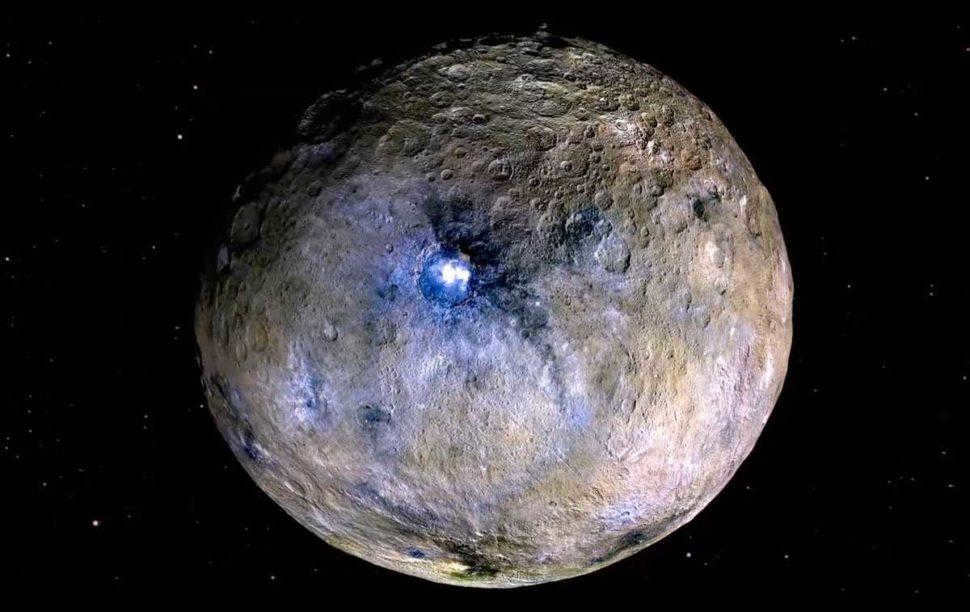
Ceres is a unique celestial object situated within the solar system. It has been categorized as both a planet and an asteroid at various stages in history. Currently, it holds the distinction of being classified as a dwarf planet.
Important details
In 1801, scientist Giuseppe Piazzi made the initial discovery of Ceres. The celestial body was named after the Roman goddess of agriculture, who was also associated with madness. Initially, Ceres was classified as a planet situated between Mars and Jupiter. However, scientific opinion shifted over time, and it was eventually reclassified as an asteroid. This reevaluation made Ceres the inaugural asteroid ever discovered by mankind and also the most massive, boasting a diameter exceeding 920 kilometers.
Surprisingly, the next shift in Ceres’ classification was connected to the examination of Pluto and objects beyond Neptune. During the 1990s, researchers started uncovering numerous celestial entities circling around Pluto, some of which were similar to or even larger in mass than Pluto itself. Subsequently, astronomers reached the conclusion that categorizing Pluto as a regular planet was incorrect. As a result, the term “dwarf planet” was coined, and both Pluto and other significant bodies in its vicinity were assigned this classification. Simultaneously, Ceres was also recognized as a dwarf planet.
The trajectory of Ceres
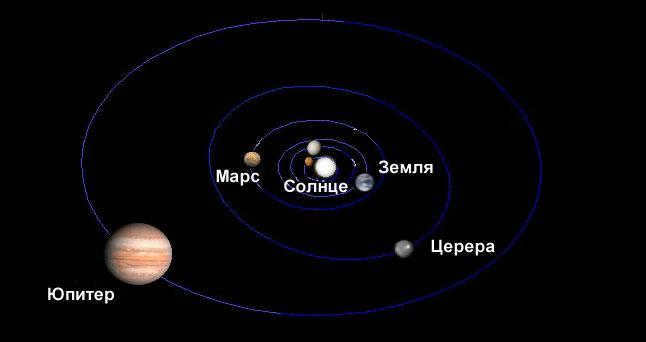
The position of Ceres’ orbit is within the asteroid belt, situated between Mars and Jupiter, and has an elliptical shape. The distance between Ceres and the Sun varies from 381 to 446.5 million kilometers. On average, the distance between Ceres and the Sun is approximately 413.7 million km. The estimated average orbital velocity of Ceres is 17.9 km/s. However, it takes Ceres approximately 1680 days, or 4.5 years, to complete one revolution around the Sun.
Ceres’ orbit is inclined at an angle of 10.59° relative to the ecliptic plane, where Earth’s orbit is located.
In addition to its orbital motion, Ceres also rotates on its own axis. It takes approximately 9 hours and 4 minutes for Ceres to complete one rotation. The axis of Ceres has an inclination of 3°.
Physical attributes
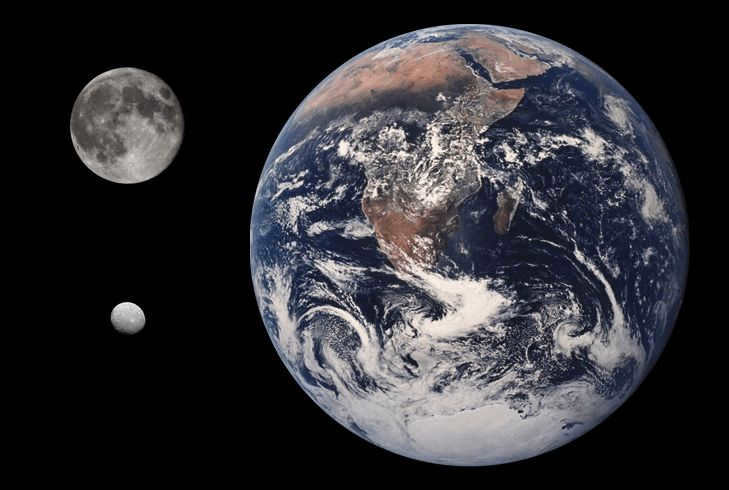
Ceres is the only dwarf planet present in the asteroid belt, making it the largest object in this region. It has a mass estimated to be around 9.4-10 20 kg, accounting for approximately 32% of the total mass in the asteroid belt. Despite its significant mass, Ceres is much smaller than Earth, with a mass that is 6350 times less.
Due to its nearly spherical shape, Ceres is classified as a dwarf planet rather than a regular asteroid. Its pole has a radius of 446 km, while the equatorial radius is slightly larger at 482 km. Ceres has a total area of 2.8 million square kilometers, which is slightly larger than the area of Argentina. Furthermore, it has a volume of 418 million cubic kilometers.
The structure of Ceres, much like conventional planets, is composed of multiple layers. At its core lies a dense rocky center, encompassed by a cryomantle comprised of frozen water ice. This cryomantle spans approximately 100 kilometers in thickness and contains a staggering 200 million cubic kilometers of water. A delicate layer of regolith, akin to the Moon’s surface, conceals the cryomantle.
Ceres possesses a density of 2.16 g/cm3 and generates its own gravitational field, albeit a feeble one. The planet’s free fall acceleration measures at a mere 0.027g.
Characterized by a grey-black hue, the dwarf planet absorbs nearly all incident light. Its albedo, which represents the fraction of reflected light, amounts to 9%. The average temperature on Ceres stands at -106°C, although during its closest approach to the Sun, temperatures can reach as high as -33°C.
Atmosphere
The atmosphere is the layer of gases that surrounds the Earth. It is held in place by gravity and is divided into five main layers: the troposphere, stratosphere, mesosphere, thermosphere, and exosphere. Each layer has its own unique characteristics and plays an important role in the Earth’s climate and weather patterns.
The troposphere is the lowest layer of the atmosphere and is where weather occurs. It is also where most of the Earth’s air mass is located. The stratosphere is above the troposphere and contains the ozone layer, which helps to protect the Earth from harmful ultraviolet radiation.
The mesosphere is the layer above the stratosphere and is the coldest layer of the atmosphere. It is also where meteors burn up upon entering the Earth’s atmosphere. The thermosphere is the layer above the mesosphere and is the hottest layer of the atmosphere. It is where the Northern and Southern Lights occur.
The exosphere is the outermost layer of the atmosphere and gradually transitions into outer space. It is where satellites orbit the Earth and is the least dense layer of the atmosphere.
Overall, the atmosphere is essential for life on Earth as it provides us with the air we breathe, protects us from harmful radiation, and regulates the Earth’s temperature. Understanding the different layers and characteristics of the atmosphere is crucial for studying and predicting weather patterns and climate change.
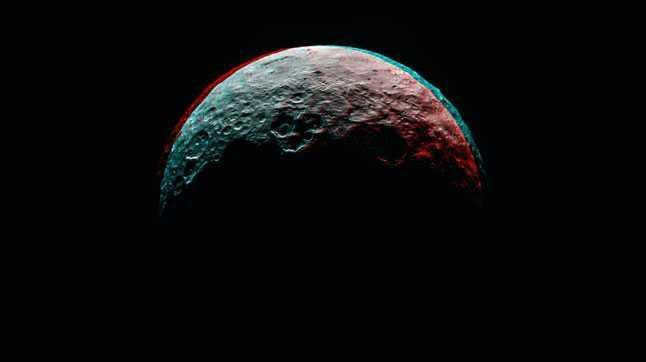

The atmosphere on Ceres is extremely thin due to its weak gravity, causing it to come and go. Composed mostly of water vapor, the appearance of the atmosphere is cyclically related to the intensity of solar radiation reaching Ceres. When the dwarf planet is in close proximity to the Sun, its surface becomes warmer, leading to the sublimation of ice. This process involves the direct transition of matter from a solid to a gaseous state, bypassing the liquid phase. Consequently, an atmosphere forms. Conversely, as Ceres moves away from the Sun, it cools down, causing the sublimation process to cease and the atmosphere to dissipate.

In 1772, Johann Bode put forward the idea that there was a planet yet to be found in the space between Mars and Jupiter. The search for this planet began in earnest in 1800, with a team of 24 astronomers dedicated to the task. However, it was not one of these astronomers who made the discovery, but rather Giuseppe Piazzi, who found Ceres in January 1801. Interestingly, Piazzi initially believed he had stumbled upon a comet, not a planet.
Interestingly, astronomers faced a challenge in observing Ceres after its discovery because of the Earth’s movement in its orbit. This led to doubts about Piazzi’s initial discovery. Several months passed before Ceres could be observed again, and its whereabouts were uncertain. It seemed as though Ceres had become a “lost” planet. Fortunately, the brilliant mathematician Carl Gauss came to the astronomers’ aid. He developed a method to calculate the orbit of Ceres based on Piazzi’s observations and completed all the necessary calculations in just a few hours. Thanks to Gauss’s work, Ceres was once again located on December 31, 1801.
Discovery
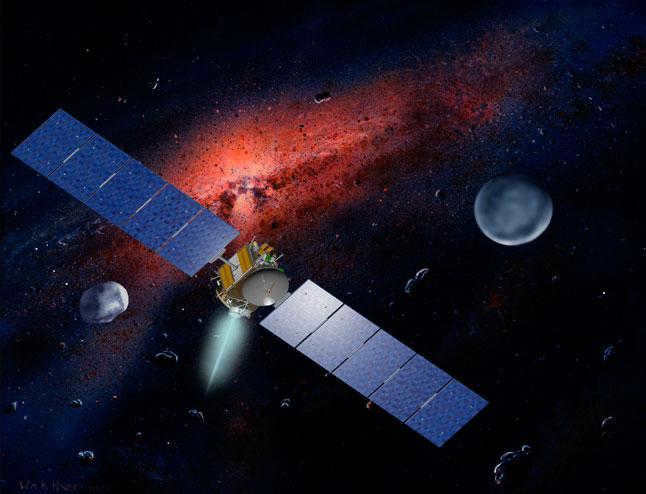
Ceres is not visible to the naked eye due to its varying stellar magnitude ranging from 6.7 to 9.32. The Hubble telescope was instrumental in making the first observations of the dwarf planet’s topography. An illuminated spot was discovered on the surface of Ceres, believed to be a deep crater containing ice, known as cryomancy. In 2015, the first 17 craters on Ceres were officially named, including the crater where the illuminated spot is located, which was named Occator after a minor Roman deity.
A major discovery in the investigation of Ceres is linked to the AMS Dawn spacecraft, which successfully entered Ceres’ orbit in 2015 and remained there for 16 months. During its mission, it was able to identify the Ahuna cryovolcano, which stands at a height of 4.5 km. Additionally, the spacecraft extensively mapped the surface of Ceres and conducted studies on its prominent white spots.
The exploration of Ceres is far from over – China has set a goal to collect and deliver soil samples from Ceres back to Earth by the year 2030.
Interesting Information
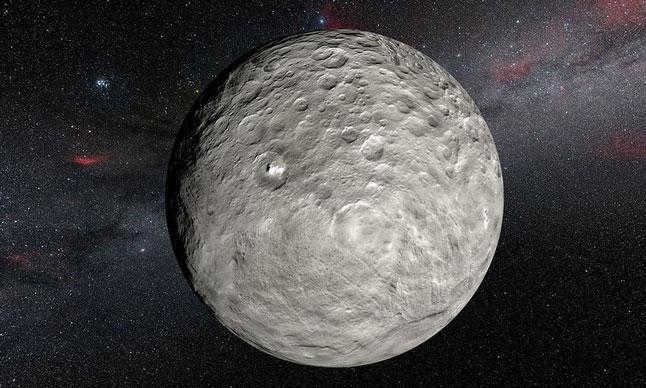
Here are a couple of fascinating details about Ceres:
Ceres got its name from the chemical element Ceres, which has an atomic number of 58 in the periodic table. It was discovered in 1803, two years after the discovery of the dwarf planet itself.
On the opposite side of Ceres from the Akhuna cryovolcano lies the Kervan crater. It is believed that they formed simultaneously – the impact of the meteorite created the crater, and the shock waves from the impact formed the Akhuna mountain. Interestingly, Ahuna is the cryovolcano closest to the Sun.
Originally, Piazzi named the planet Ceres Ferdinand. Ferdinand was the name of the reigning king of Sicily at the time. Later, the king’s name was removed from the planet’s name.
List of sources used
– https://ru.wikipedia.org/wiki/Церера
– https://in-space.ru/planeta-cerera/
– https://prokocmoc.ru/karlikovye-planety/tserera/
– https://hightech-fm.turbopages.org/s/hightech.fm/2020/08/11/ceres-dawn
The bright areas on Ceres, a dwarf planet in our solar system, have finally been explained. Scientists have long been puzzled by the origin of these luminous spots on the surface of this celestial body. Ceres holds great interest for astronomers due to its many unanswered questions. Could it possibly harbor life as we know it?
Read “Hitech” at.
What sets Ceres apart?
Is it a dwarf planet or a massive asteroid?
Ceres, the largest object in the asteroid belt between Mars and Jupiter, is a dwarf planet that stands out in the inner solar system. In 2015, NASA’s Dawn mission made history by being the first spacecraft to visit a dwarf planet when it arrived at Ceres.

For many years, Ceres has been referred to as an asteroid, but due to its significant size and distinct characteristics compared to other rocky objects, scientists reclassified it as a dwarf planet in 2006. Despite composing 25% of the asteroid belt’s total mass, Ceres is still dwarfed by Pluto, which is 14 times larger and more massive.
Ceres experiences the shortest daylight hours among all celestial bodies in the solar system and lacks seasonal variations.
Ceres completes one orbit around the Sun in 1,682 Earth days, equivalent to 4.6 Earth years. During its revolution, Ceres rotates every 9 hours, resulting in extremely brief daylight hours compared to other celestial bodies in the solar system.
An embryonic planet that was interfered with by a neighboring celestial body
Ceres came into existence approximately 4.5 billion years ago, during the formation of the solar system. At that time, gravitational forces attracted swirling gas and dust, resulting in the creation of this small dwarf planet. Scientists refer to Ceres as a “proto-planet” since it began to form but was unable to complete the process. The powerful gravitational pull of nearby Jupiter hindered its development into a fully-fledged planet. Eventually, around 4 billion years ago, Ceres settled into its current position amidst the remnants of planetary formations within the asteroid belt located between Mars and Jupiter.
What is the potential for life on Ceres?
Ceres exhibits some similarities to the Earth-group planets, including Mercury, Venus, Earth, and Mars, rather than its neighboring asteroids. However, it differs in terms of density, being much less dense. One shared characteristic is its layered structure, although the layers on Ceres are not as well-defined. It is believed to possess a solid core and a mantle consisting of water ice, potentially making up about 25% of its composition. In fact, Ceres may have more water than Earth. Its crust is comprised of rocky and dusty material, with notable deposits of salt. These salts, however, differ from table salt, consisting of other minerals like magnesium sulfate.
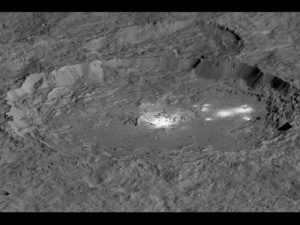
Ceres is populated with numerous small fresh craters, but none of them surpass a diameter of 280 km. It is quite unexpected considering the fact that this dwarf planet should have encountered numerous massive asteroids throughout its 4.5 billion years of existence.
The absence of craters might be attributed to layers of ice just beneath the surface. If ice or other materials with lower density, like salt, are present just below the surface, it is possible that surface features have gradually smoothed out over time. Another possibility is that previous hydrothermal activities, such as ice volcanoes, have erased some of the larger craters.
Several of Ceres’ craters contain areas that are perpetually in shadow. It is conceivable that water ice could persist in these “cold traps” for extended periods of time without direct exposure to sunlight.
Ceres possesses a notably tenuous atmosphere, with indications of the presence of water vapor. The vapor could potentially originate from cryovolcanoes or the sublimation of surface ice, transitioning from a solid to a gaseous state.
Ceres stands out as one of the celestial bodies within our solar system that holds intrigue for researchers in their quest for potential signs of life. A distinguishing feature that sets it apart from many other planets is the presence of water. On our own planet, water is considered a fundamental requirement for life, hence raising the possibility that, given this crucial component and other necessary conditions, life might thrive there. If living organisms exist on Ceres, they would likely be diminutive microorganisms, akin to bacteria. Although it may not currently host any living entities, there might be indications of past life on this celestial body.
What did scientists discover?
NASA’s Dawn spacecraft provided scientists with a unique and up-close look at Ceres, the dwarf planet. The mission concluded in October 2018, during which the orbiter descended to a distance of less than 35 kilometers from the planet’s surface. This close proximity allowed scientists to observe and study the enigmatic bright areas on Ceres in great detail.
Through their research, scientists have determined that these bright areas consist predominantly of sodium carbonate, which is a compound made up of sodium, carbon, and oxygen. These deposits likely formed from a liquid that seeped through to the surface and subsequently evaporated, leaving behind a highly reflective salt crust. However, the exact source of this liquid has yet to be identified.
Scientists studying the data collected during the Dawn mission have concluded that the liquid found near the end of the mission originated from a deep reservoir of “brine,” which is water enriched with salt. Through their analysis of Ceres’ gravity, scientists have gained insights into the internal structure of the dwarf planet. They have determined that the brine reservoir is approximately 40 kilometers deep and extends hundreds of kilometers in width.
Ceres does not experience internal heating due to gravitational interactions with a larger planet, unlike some of the icy moons in the outer solar system. However, a recent study focusing on Ceres’ Occator crater, measuring 92 kilometers in diameter and housing the most prominent bright areas, confirms that Ceres is a water-rich world similar to these other icy celestial bodies.
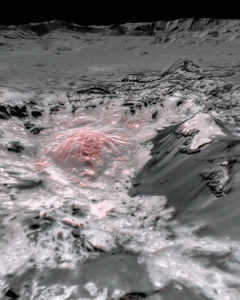
The findings, which also demonstrate the magnitude of geological activity within the Occator crater, have been published on August 10th in the scientific journals Nature Astronomy, Nature Geoscience, and Nature Communications.
Dawn has achieved far beyond our initial expectations as it embarked on its extraordinary extraterrestrial journey. These exhilarating recent revelations, following a lengthy and fruitful mission, serve as a remarkable testament to the capabilities of this interplanetary explorer.
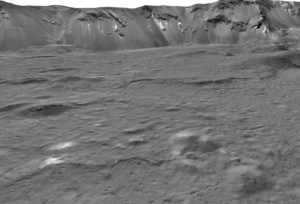
The majority of the salts in the Cerealia Facula deposit originated from the slush located just beneath the surface. This slush was melted by the heat generated from the impact that occurred approximately 20 million years ago and formed the crater. Although the effects of the heat diminished after several million years, the impact also caused significant fractures. These fractures may have extended into a deep and long-lasting reservoir, enabling brine to continuously seep up to the surface.
Carol Raymond, chief investigator for the Dawn mission.
Dynamic geology: recent and uncommon
In our solar system, icy geological activity is primarily found on icy moons, where it is driven by their gravitational interaction with their respective planets. However, the movement of brine to the surface of Ceres suggests that other large bodies rich in ice, which are not moons, may also exhibit activity.
Signs of fluid movement in Occator crater have become apparent due to the presence of bright deposits on the surface. Additionally, the discovery of numerous intriguing conical hills resembling Earth’s pingos – small ice mountains in polar regions formed by frozen groundwater under pressure – further supports this notion. While similar features have been observed on Mars before, their presence on Ceres represents the first documented occurrence on this dwarf planet.
Scientists have achieved a significant breakthrough in understanding the structure of Ceres, a planetary body rich in ice. For the first time, they were able to map the density of Ceres’ crustal structure as it varies with depth. By analyzing gravity measurements, they discovered that the density of Ceres’ crust increases significantly as you go deeper, indicating that there are factors beyond just pressure at play. The researchers concluded that as Ceres’ reservoir freezes, salt and silt are able to penetrate the lower crust.
Further information:
Ceres is a dwarf planet located in the asteroid belt between Mars and Jupiter.
In the solar system, there is a fascinating region known as the Asteroid Belt. In addition to containing an enormous amount of material, estimated to be between 2.8-3.2 quintillion tons, this area is also home to numerous small dwarf bodies. Among these, the largest is a dwarf planet called Ceres.
Initially, scientists were puzzled by the size and shape of Ceres, leading them to believe it was a planet. However, subsequent research prompted a reconsideration of this conclusion, although the object’s significant mass allows it to maintain a spherical form. The status of Ceres is still a topic of debate. To learn more about this dwarf planet and its precise location, continue reading.
In 1801, Giuseppe Piazzi discovered the dwarf planet Ceres while he was searching for zodiacal stars. However, the existence of this dwarf planet had already been predicted by Johann Bode, who believed that there should be a planet located between Mars and Jupiter. Bode’s prediction was based on the Bode-Titius law (1766), which is now considered invalid.
The Bode-Titius law proposed that the semi-major axes of planets follow a specific pattern, with the exception of the gap between Mars and Jupiter. In 1800, Franz Xaver von Zack asked twenty-four experienced astronomers to search for the missing planet in order to confirm this law. The image below shows Ceres as captured by the Hubble Space Telescope.
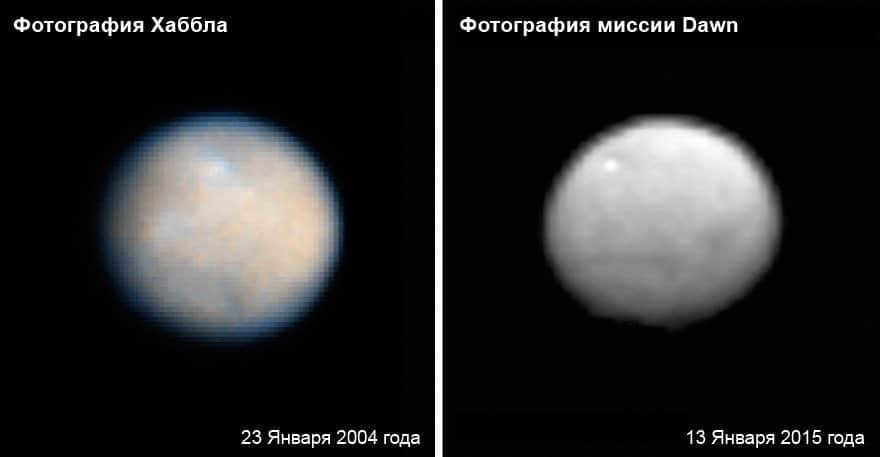
Comparison of images of Ceres taken with an 11-year interval
One of the astronomers who made the discovery of Ceres was Giuseppe Piazzi. However, initially he mistook it for a comet. Upon further examination, it became clear that the object was something larger. The definitive conclusions were presented in 1801.
Due to its proximity to the Sun, Ceres shifted and disappeared from view. It was later rediscovered and the discovery was confirmed. From the start, Piazzi had intended to name the object Ceres Ferdinande, in honor of the goddess of agriculture and the king. However, the second part of the name was not accepted in other countries, so “Ceres” stuck. In Germany, it was called Hera, and in Greece, they still adhere to the variant Demeter.
Classification
There have been numerous changes in the classification of the object. Johann Bode was of the opinion that it should be classified as a genuine planet. This classification remained in place until the mid-19th century.

Ceres and other significant asteroids
With the discovery of additional celestial objects and their subsequent study, scientists began to speculate about the existence of another classification. In 1802, William Herschel introduced the term “asteroid,” and Ceres was designated as such. By 1860, a distinction was made between objects like Ceres and planets, although no precise definition for the latter had been established. During the 2006 controversy, Ceres was classified as a planet.
The International Astronomical Union (IAU) later established new criteria for planetary classification, requiring objects to not function as satellites, possess a certain mass, and clear their orbital vicinity. As Ceres is not a dominant celestial body, it shares its orbit with a vast number of asteroids.
Dimensions, weight, and trajectory
In 1802, William Herschel estimated a size of 260 km, while Johannes Schroeter argued for 2613 km in 1811. The current measurement is 473 km, and Ceres has a mass of 9.39 x 10 20 kg (0.00015 Earths).
Physical attributes of the Ceres dwarf planet
The Ceres dwarf planet accounts for one-third of the overall asteroid mass (4% of the Moon) within the asteroid belt. Nevertheless, its considerable weight is enough to maintain it in a nearly spherical shape. It follows a slightly inclined yet moderately eccentric orbit. Its closest approach to the Sun is at 382.6 million kilometers, while its farthest point is at 445.4 million kilometers. The time it takes to complete one orbit around the Sun is 4.6 years, and it takes 9 hours and 4 minutes to complete one rotation around its own axis.
Composition and atmosphere
With a density of 2.16 g/cm3, Ceres consists of a rocky core and an icy mantle. Observations from the Keck Observatory in 2002 confirmed that the icy mantle extends 100 km and contains about 200 million km3 of water. In addition, infrared data from the surface suggests the possibility of an ocean beneath the icy mantle, which could potentially support microbial life. The figure illustrates the structure and composition of Ceres.
The internal structure of Ceres
The surface of Ceres may contain iron-rich clay and carbonates. This surface layer is relatively warm, with temperatures reaching -38°C. The presence of hydroxide ions further supports the existence of a weak atmosphere, as the ice would lose stability if there was enough antifreeze. Additionally, in 2014, water vapor was detected, indicating the presence of erupting cryovolcanoes caused by internal heat and subsurface pressure.
Origins
The beginnings of something, its roots, or where it first came from.
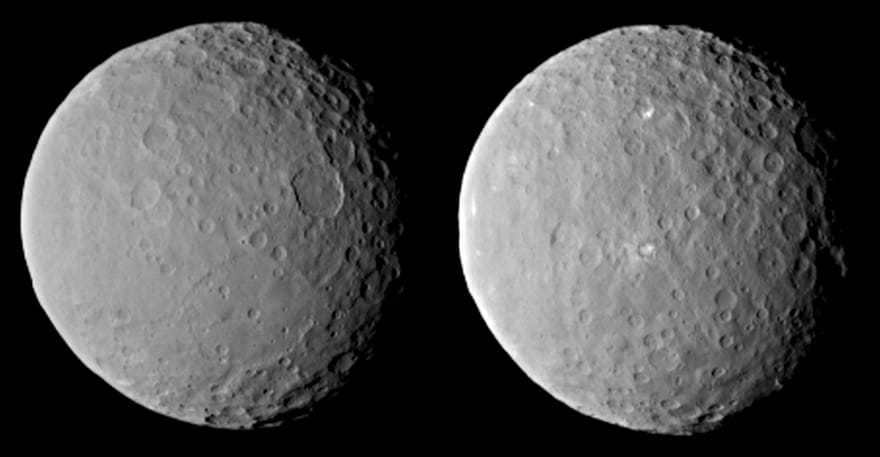
A color image of Ceres taken by the Dawn spacecraft in 2015
What is the origin of the dwarf planet Ceres? There are various theories regarding this. Some suggest that it is a surviving protoplanet that formed 4.57 billion years ago in the asteroid belt. It did not undergo merging with other bodies and did not attain the status of a terrestrial planet. Jupiter also did not eject it into the outer system. Another theory proposes that the object originated in the Kuiper belt and subsequently migrated to the asteroid belt.
The advancement of geology relies on thermal origins. It is theorized that Ceres obtained a solid core and frozen mantle through planetary accumulation and the decay of radioactive elements. Over time, the surface evaporated, revealing hydrated minerals.
Currently, there is no detectable geological movement and the surface displays numerous impact craters. The existence of water ice suggests the presence of internal reservoirs.
Research
Until recently, there was limited knowledge about Ceres. It was not until 1995 that the Hubble telescope was able to capture a detailed image of Ceres, which revealed a dark spot on its surface. This particular crater was subsequently named Piazzi.
In 2002, the Keck telescope captured a series of close-up infrared images, which showcased various bright and dark features that appeared to move as Ceres rotated. Then, in 2003-2004, Hubble’s visible-light images revealed 11 previously unidentified features, the nature of which remains a mystery.
In 2015, the Dawn spacecraft embarked on a mission to study both Ceres and Vesta. It made significant discoveries, including the presence of numerous craters on Ceres, indicating the likelihood of an icy surface. Some of these craters featured bright spots with an albedo of 40%, suggesting the possible presence of ice or salt that reflects the sun’s rays.
Photographs
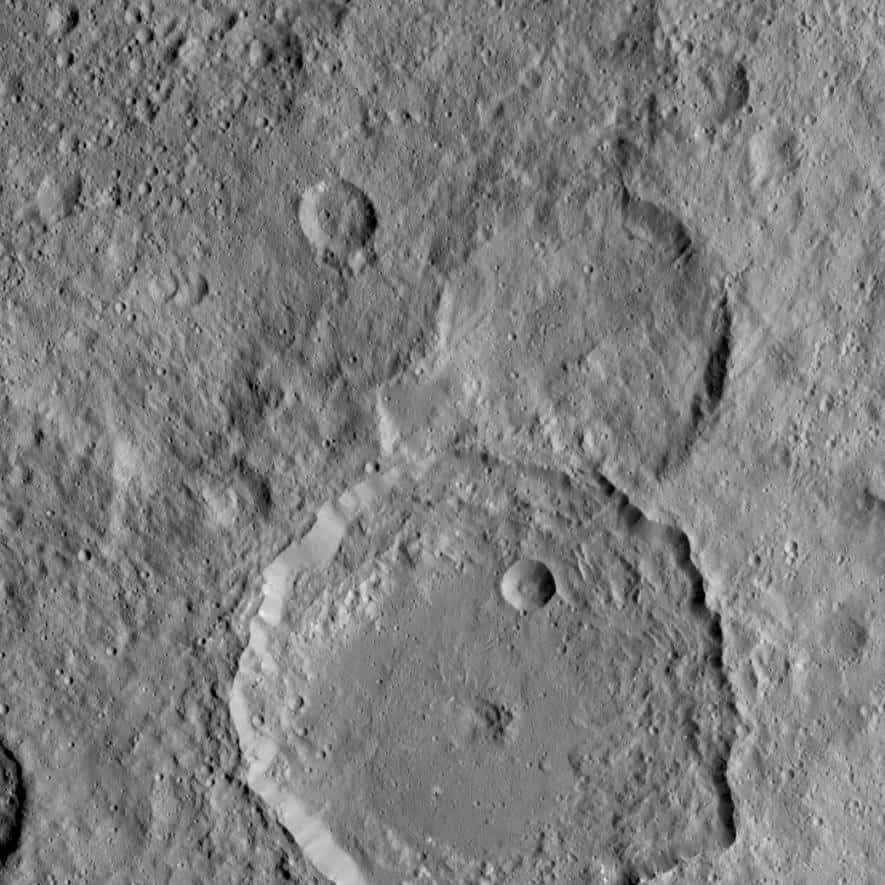
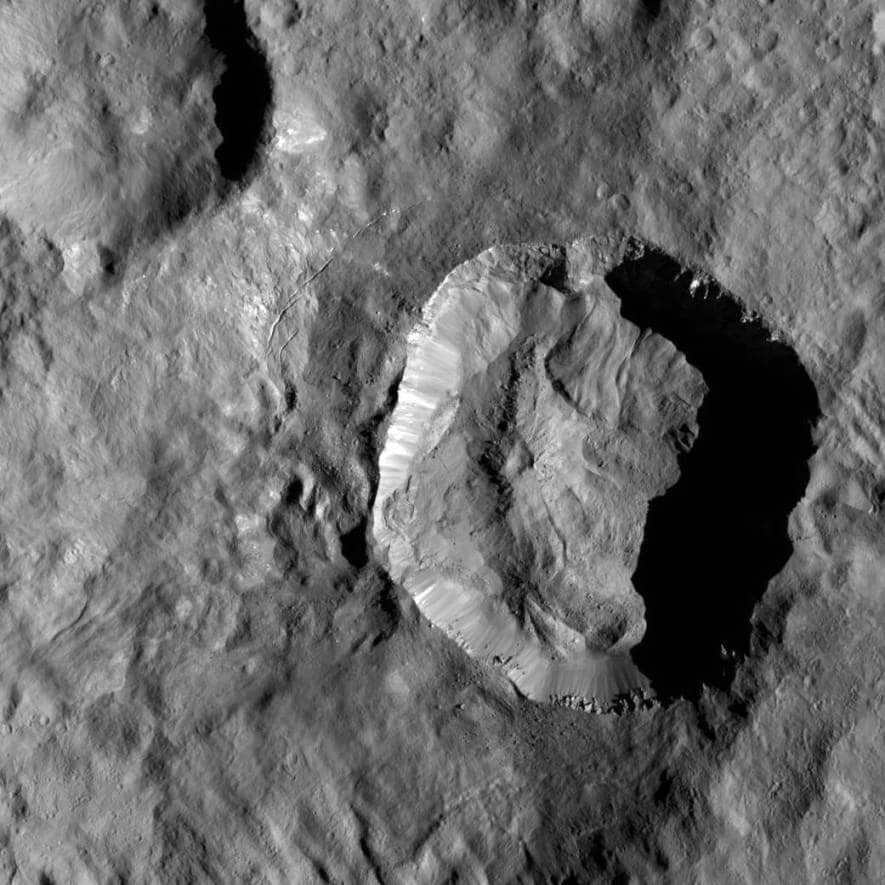
This high-quality image of Ceres displays the Juling crater, which reaches a depth of 2.5 km. On the left side, a small mountain with a height of 1 km stands out. Numerous formations suggest the movement of material and the existence of subterranean ice reserves. A slight depression is noticeable on the mountain’s summit, its origin still remaining a mystery. It could possibly be the result of a landslide. This view was captured by the spacecraft on August 25, 2016, while flying at an altitude of 385 km (at coordinates 36 degrees S and 167 degrees E). Juling relates to a spirit in Malaysian culture. The Dawn mission falls under the jurisdiction of the Jet Propulsion Laboratory, which is an integral part of the broader Discovery project.
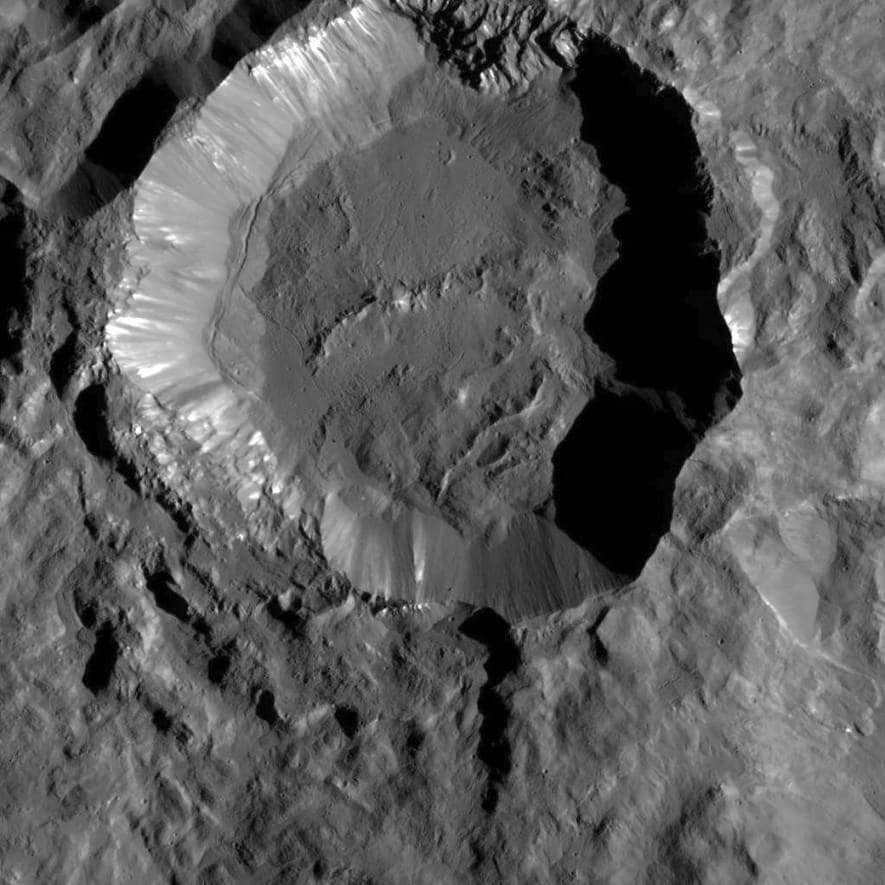
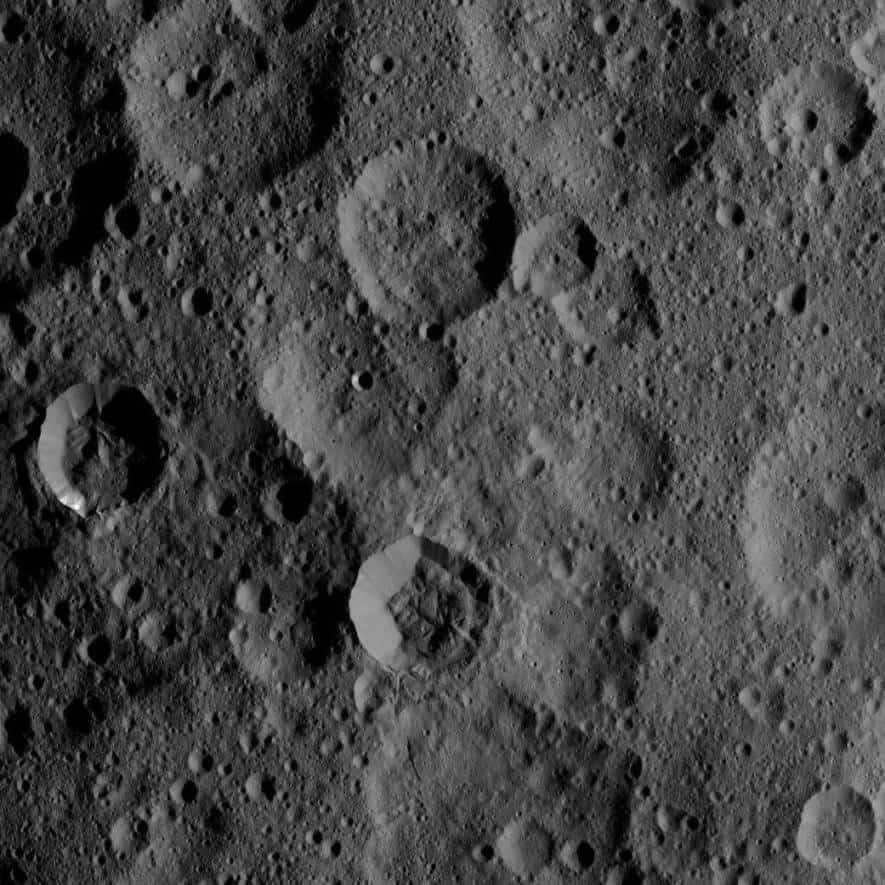
The Dawn mission successfully imaged craters Takel and Kozobi on Ceres using its advanced imaging equipment. Takel, a relatively new crater, is characterized by its association with bright material, which is clearly visible on the left side of the image. On the other hand, Kozobi is a distinct impact mark located slightly below the center of the image. The Dawn mission, led by the Jet Propulsion Laboratory, is an integral part of the larger Discovery project, which aims to explore and study celestial bodies within our solar system.
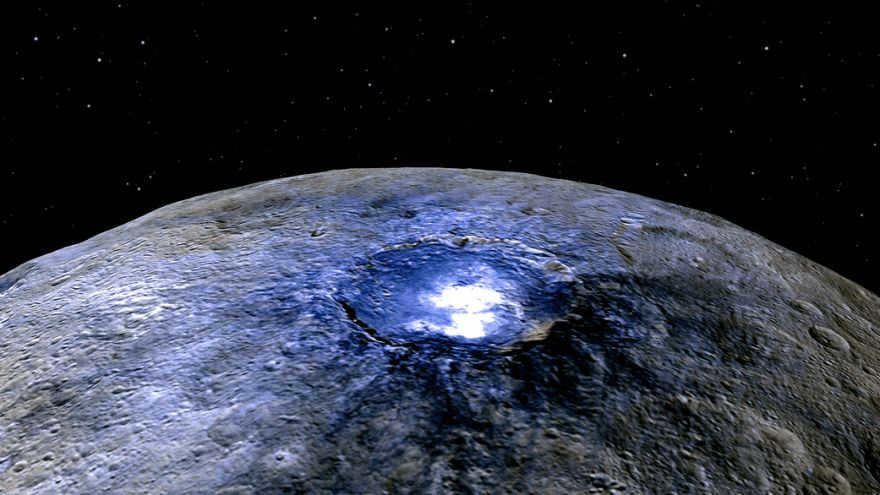
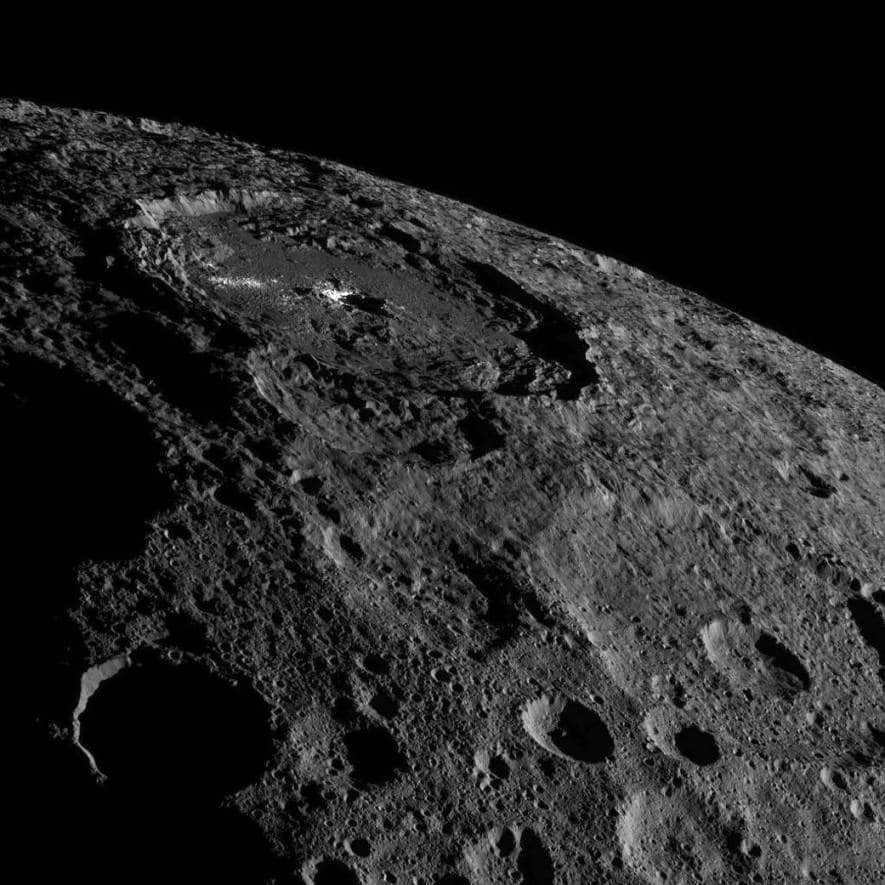
This image depicts the boundary of Ceres, a small planet, and the northern hemisphere region. The remarkable Occator crater is particularly striking. It spans a distance of 92 kilometers and has a depth of 4 kilometers. This is compelling evidence of recent geological activity. Analysis reveals that the material within the crater is composed of salt, which was left behind as the liquid substance underwent freezing and subsequent sublimation, transitioning from ice to vapor. The image was captured by the Dawn spacecraft on October 17th from a distance of 1,480 km. The resolution is 140 meters per pixel. The Jet Propulsion Laboratory is responsible for overseeing the Dawn mission, which is part of the larger Discovery project.
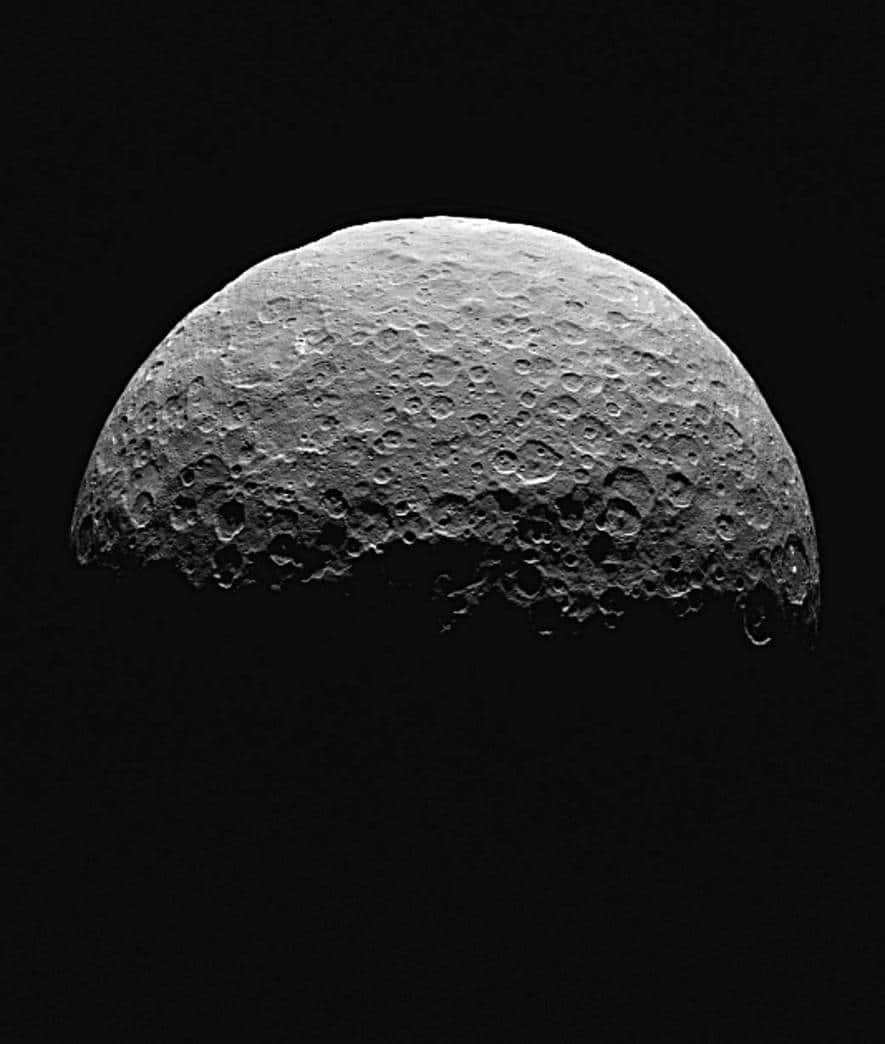
The Dawn spacecraft captured this image on April 14-15 while flying at an altitude of 22,000 km, revealing the sunlit northern section. On April 23, the spacecraft entered a circular orbit. The two close bright spots in the image are commonly known as “spot 5”. The image has a scale of 2.1 kilometers per pixel, and the angle between the Sun, Ceres, and the spacecraft is 91 degrees. The Dawn mission is overseen by the Jet Propulsion Laboratory as part of the broader Discovery program.
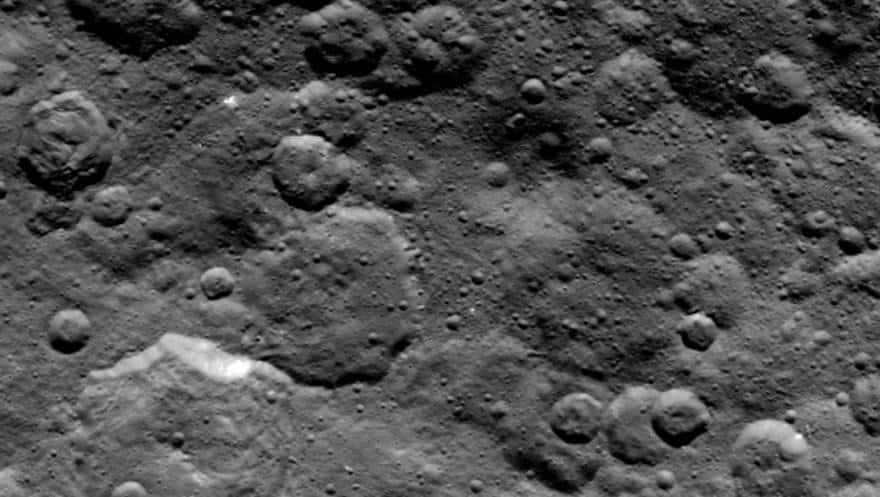

On June 6, 2015, the Dawn spacecraft managed to capture craters on the north side of the dwarf planet Ceres. This is one of the first images from the second orbital pass at an altitude of 4,400 km with a resolution of 410 meters per pixel. The Jet Propulsion Laboratory is responsible for the Dawn mission. It is part of the more global Discovery project.
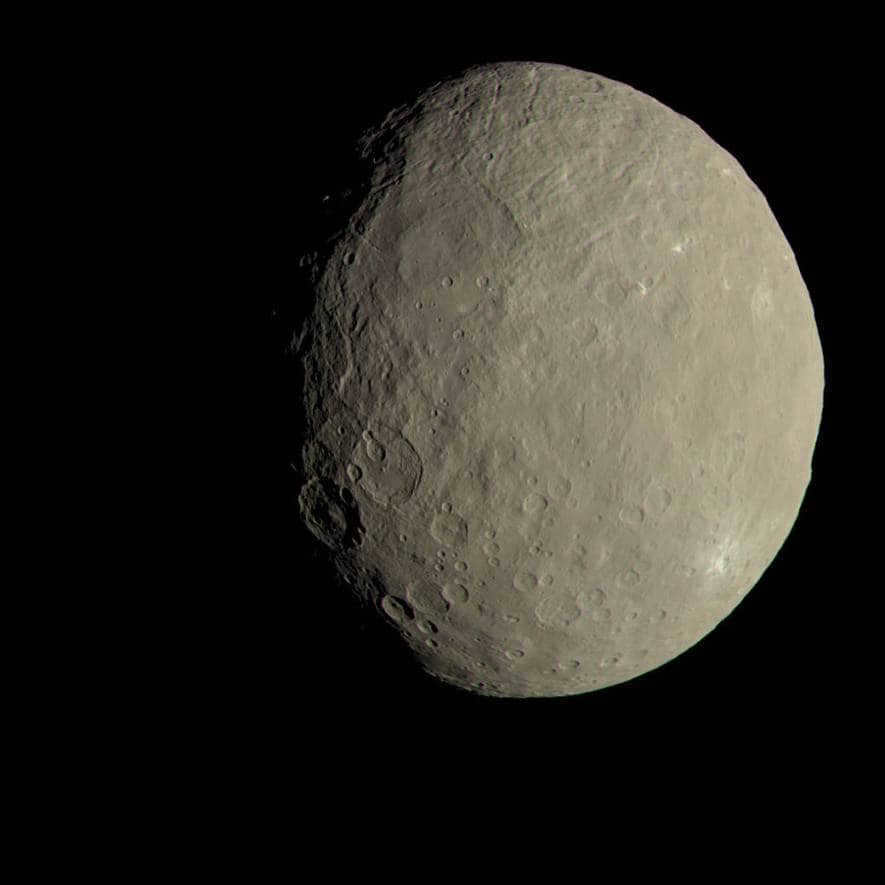

The photograph showcases the color of Ceres as perceived by the human eye. It was created at the German Aerospace Center (Berlin) by combining imagery from Dawn taken in 2015 using red, green, and blue spectral filters. The Dawn mission is managed by NASA’s Jet Propulsion Laboratory. The project is part of the Discovery program, with UCLA being responsible.
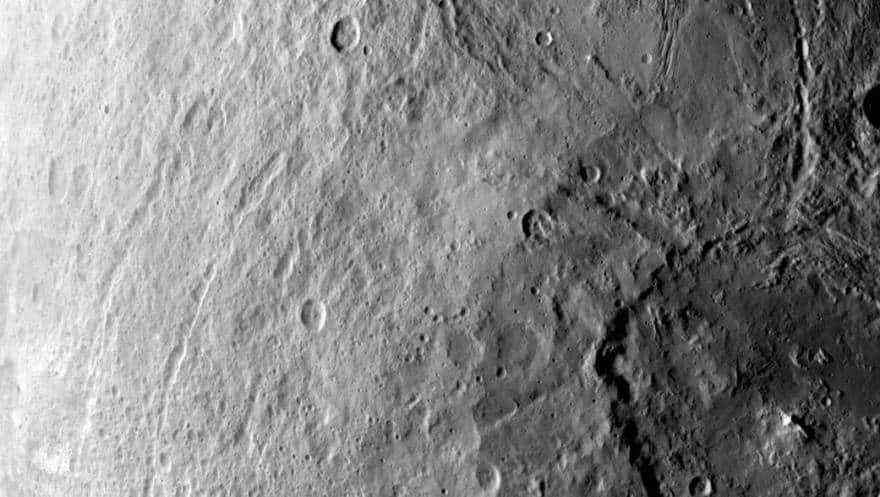

June 6, 2015 witnessed the successful capture of two of Ceres’ most luminous spots by the Dawn spacecraft. This remarkable feat was accomplished at an elevation of 4,400 kilometers, enabling the resolution to reach an impressive 410 meters per pixel. The scientific community is currently engaged in extensive research to unravel the enigmatic nature of these conspicuous spots. One prevailing theory suggests the possible presence of salt and ice. The esteemed Jet Propulsion Laboratory bears the responsibility of overseeing the remarkable Dawn mission, which forms an integral part of the broader Discovery project.
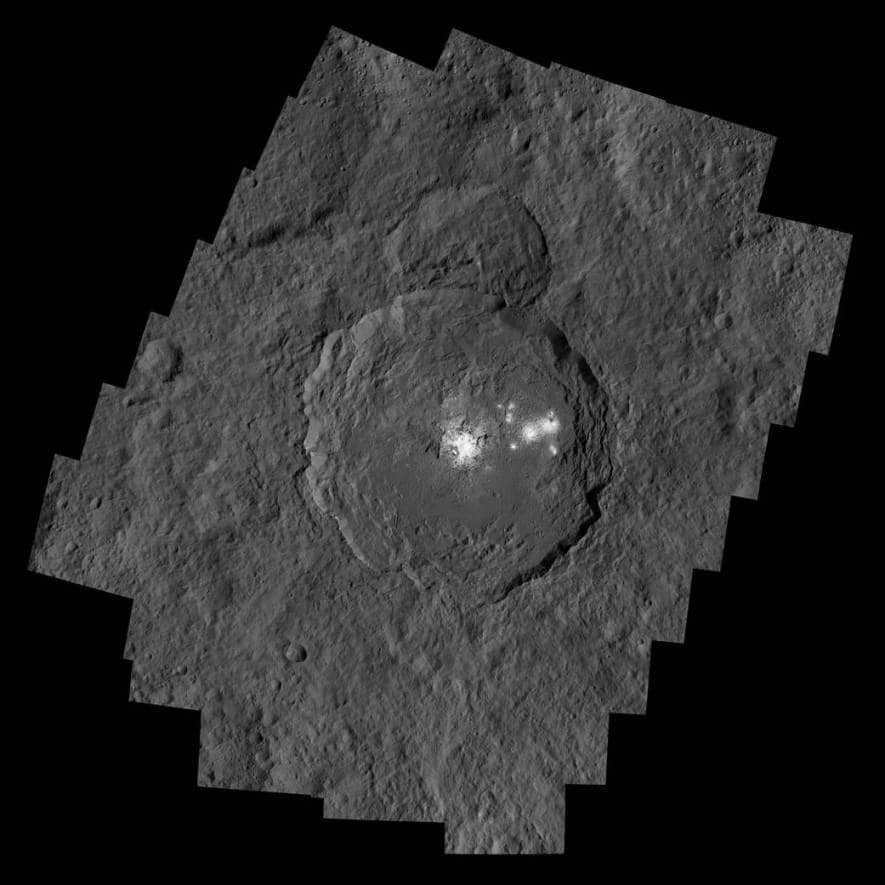
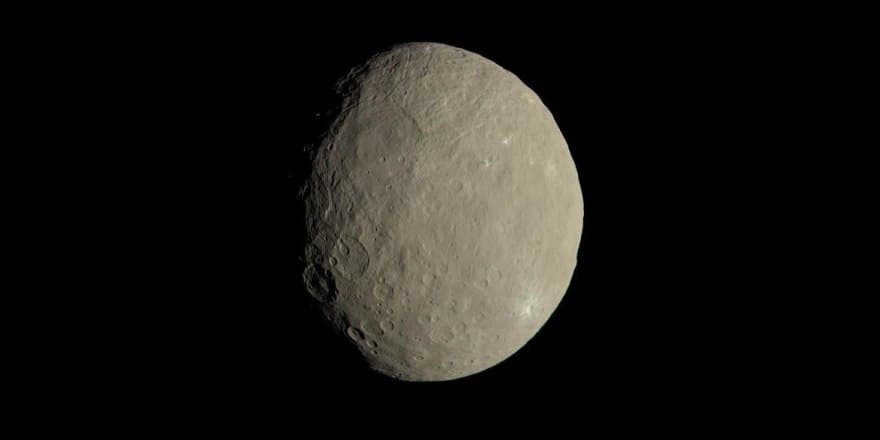
Ceres, one of the dwarf planets in our solar system, stands out as an outcast or loner amongst its celestial companions. Moreover, it has lost its former title of being the “largest” and is now recognized as the smallest dwarf planet in our system.
In search of a vanished planet

A photograph taken by the Dawn spacecraft in 2015 displays the colorful view of Ceres.
In 1772, Bode’s law, also known as the Titius-Bode rule, was gaining popularity. This rule served as a formula that provided an estimate of the distances at which the planets in our solar system should be located, based on their average orbital radius. The discovery of Uranus in 1781 further supported this rule, suggesting that there should be an object situated between Mars and Jupiter.
Various groups were formed to search for this object, but it was an Italian astronomer named Giuseppe Piazzi who happened to stumble upon it in 1801. Piazzi, who was originally searching for a star, mistook Ceres for a comet at first. However, its true identity would be revealed much later.
Issues with Classification

Ceres and other significant asteroids
The status of Ceres has been a subject of debate for a long time. This is not surprising, as new data has expanded our understanding of not only the solar system but also the nature of its objects. The first person to argue in favor of Ceres’ planetary status was Johann Bode. He genuinely believed that it was an undiscovered world that, according to the formula, should exist in this location.
Ceres was initially designated in the catalog and was considered a planet for nearly half a century. However, it is important to remember that Ceres is located in the asteroid belt. Eventually, scientists started to observe other similar objects and decided to reclassify Ceres as an asteroid.
Instead of being a tiny planet, Ceres has now taken on the role of being the largest asteroid in the asteroid belt. However, this is not the end of the story. The discussion surrounding the nature of Pluto has had implications for many other objects, leading to a reconsideration of their classifications. This includes Ceres, which is now considered a dwarf planet. Interestingly, even the International Astronomical Union is still grappling with confusion and sometimes uses a dual designation for such objects. Therefore, we can conclude that Ceres is both the largest asteroid and the smallest dwarf planet in the entire solar system.
The structure inside Ceres is unique.
Ceres completes a full orbit around the Sun in 4.6 years, which is equivalent to an average distance of 2.77 a.u. If one were to establish a settlement on this celestial body, the duration of a single day would be a mere 9 hours and 4 minutes. Despite the ongoing debate surrounding its classification, Ceres continues to maintain its position as the largest object within the asteroid belt.
In terms of dimensions, Ceres spans an area of 975 x 909 kilometers and possesses only 1.3% of the moon’s mass (although it is considered the most massive object in the asteroid belt). Interestingly, this dwarf planet remains solitary, with no other similar objects nearby. The remaining known dwarf planets can be found beyond Neptune.
Thanks to NASA’s Dawn, high-resolution images and detailed characterization of the dwarf planet were captured in 2015.
Here are some fascinating facts about Ceres:
- The average surface temperature ranges from -106°C to -33°C.
- Ceres became the first dwarf planet to be explored by a spacecraft.
- The icy mantle has the capacity to hold approximately 200 million km 3 of water, which is more fresh water than Earth.
- The presence of active cryovolcanoes, which emit vapor jets, is suspected.
- There is a belief that Ceres has a weak atmosphere containing water vapor.
- Bright white spots have been discovered within one of the craters, and it is suspected that they may consist of ice or salt.
- Maybe there is a protoplanet that has managed to survive the intense collisions and formation process 4.57 billion years ago.
Images of Ceres
Gau crater on Ceres

Juling Crater
The Juling Crater is a geological formation located in a remote region of the planet. It is characterized by its unique structure and composition. The crater was formed millions of years ago as a result of a powerful cosmic impact. Over time, erosion and other geological processes have shaped the crater into its current form.
One of the most striking features of the Juling Crater is its size. It spans several kilometers in diameter and is one of the largest craters in the region. The walls of the crater are steep and rugged, with jagged rocks jutting out at various angles.
The composition of the Juling Crater is also fascinating. Scientists have discovered a wide variety of minerals and rock formations within the crater. These include rare elements and compounds that are not typically found in other parts of the planet. The unique combination of these minerals has led to the formation of colorful patterns and textures on the crater walls.
Due to its remote location, the Juling Crater is relatively untouched by human activity. It is a pristine environment that offers scientists a valuable opportunity to study the geological processes that have shaped our planet. Researchers from around the world travel to the crater to collect samples and conduct experiments.
In addition to its scientific significance, the Juling Crater is also a popular destination for tourists and adventure seekers. The rugged landscape and stunning views make it an ideal location for hiking, camping, and other outdoor activities. Visitors can explore the crater on foot or take guided tours to learn more about its geological history.
Overall, the Juling Crater is a remarkable geological formation that offers a glimpse into the history and natural beauty of our planet. Its unique structure, composition, and remote location make it a valuable site for scientific research and a popular destination for tourists.

The Cupalo Crater on the dwarf planet Ceres

Takel and Kozobi craters
can be rephrased as
The craters of Takel and Kozobi
.

The craters of Takel and Kozobi, situated on Ceres, were successfully photographed by the Dawn spacecraft. Takel is a recently formed crater that is connected to bright material on the left side, while Kozobi is a distinct impact mark located slightly below the center. The Dawn mission, which is part of the broader Discovery project, is led by the Jet Propulsion Laboratory.
False color image of Occator crater

A crater on the edge of Ceres.

Investigation of Ceres

This photograph was captured by the Dawn spacecraft on April 14-15 while flying at an altitude of 22,000 km, revealing the sunlit northern region. On April 23, the spacecraft transitioned into a circular orbit. The prominent feature, known as “spot 5,” consists of two closely situated bright spots. The image resolution is 2.1 kilometers per pixel, and the angle between the Sun, Ceres, and the spacecraft is 91 degrees. The Jet Propulsion Laboratory is in charge of the Dawn mission, which is part of the larger Discovery program.
The northern hemisphere of Ceres


On June 6, 2015, the Dawn spacecraft managed to capture craters on the northern side of the dwarf planet Ceres. This is one of the first images from the second orbital pass at an altitude of 4,400 km with a resolution of 410 meters per pixel. The Jet Propulsion Laboratory is responsible for the Dawn mission. It is part of the more global Discovery project.
Ceres in color


This image depicts Ceres in color as seen by the human eye. The overview was produced at the German Aerospace Center in Berlin by merging footage from Dawn captured in 2015 using red, green, and blue spectral filters. The Dawn mission falls under the jurisdiction of NASA’s Jet Propulsion Laboratory. UCLA has the responsibility for the project as part of the Discovery program.
The southern hemisphere of Ceres

Positive aspects in the second mapping orbit of Ceres

Occator Crater and the most illuminated areas.

The Occator crater, with a diameter of 92 km and a depth of 4 km, contains the brightest region on Ceres. A closer look from the Dawn spacecraft reveals a dome at the center of the smooth crater. Linear formations and fractures extend upwards and diverge on the sides. Additionally, there are visible fractures surrounding the bright areas. The image is composed of two photos taken at a shorter exposure, allowing for the details of the bright objects to be captured. These photos were taken by the LAMO camera at an altitude of 385 kilometers above Ceres. The Dawn mission, which is part of the broader Discovery project, is overseen by the Jet Propulsion Laboratory.

